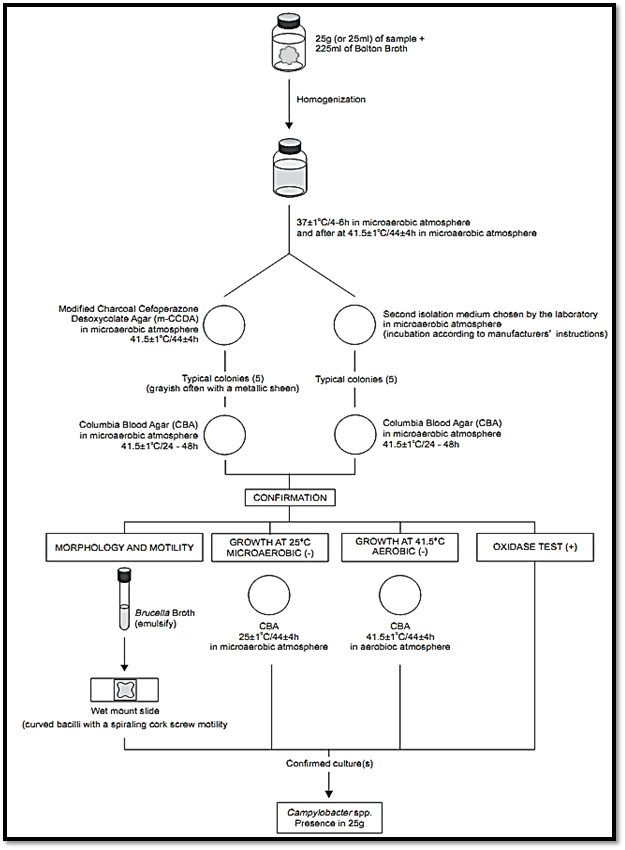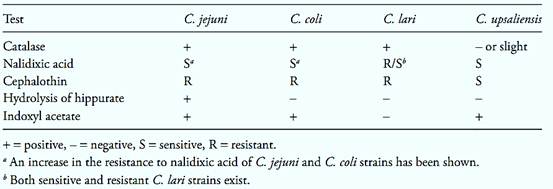Presence/absence method ISO 10272-1:2006 for thermotolerant Campylobacter in foods
This method of the International Organization for Standardization is applicable to products intended for human consumption or for the feeding of animals, and to environmental samples in the area of food production and food handling.
Since Campylobacter spp. are very sensitive to freezing but survive best at low temperatures, it is recommended that samples to be tested should not be frozen, but stored at 3 ± 2°C and subjected to analysis as rap-idly as possible. Also take care to prevent the samples from drying.
1. Material required for analysis
Obligatory
• Bolton Broth
• Modified Charcoal Cefoperazone Deoxycholate Agar (mCCDA)
• Columbia Blood Agar (CBA)
• Brucella Broth
• Oxidase Kovacs Reagent
• Microaerobic gas-generating kits
• Laboratory incubator set to 37 ± 1°C
• Laboratory incubator set to 41.5 ± 1°C
• Laboratory incubator set to 25 ± 1°C
Optional
• Mueller Hinton Blood Agar
• 3% Hydrogen Peroxide
• Nalidixic acid (30 μg) discs
• Cephalothin (30 μg) discs
• Sodium Hippurate Solution
• Ninhydrin Solution
• Indoxyl acetate discs (2.5 to 5.0 mg)
2. Procedure
A general flowchart for the detection of thermotolerant Campylobacter in foods using the presence/absence method ISO 10272-1:2006 is shown in Figure 1.
a) Enrichment: Homogenize 25 g or 25 ml of sample with 225 ml of Bolton Broth. Incubate at 37 ± 1°C/4–6 h, then at 41.5 ± 1°C/44 ± 4 h, in a microaerobic atmosphere (oxygen content of 10 ± 3%, carbon dioxide 5 ± 3%, optional hydrogen ≤10%, with the balance nitrogen).
Note a.1) the sample quantity of analytical unit can vary, as long as the dilution 1:10 is kept.
Note a.2) The appropriate microaerobic atmosphere can be obtained using commercially available gas-generating kits, following precisely the manufacturers’ instructions, particularly those relating to the volume of the jar and the capacity of the gas-generating kit. Alternatively, the jar may be filled with an appropriate gas mixture prior to incubation. As an alternative to incubation in a microaerobic atmosphere, the enrichment broth can be incubated in screw capped bottles or flasks filled with enrichment broth, leaving a headspace of less than 2 cm, and tightly closing the caps.
b) Selective-differential plating: Using the culture obtained in the Bolton Broth, inoculate the surface of the selective isolation medium, Modified Charcoal Cefoperazone Deoxycholate Agar (mCCDA). Proceed in the same manner with a second Campylobacter selective isolation medium, chosen by the laboratory. Incubate the m-CCDA plates at 41.5 ± 1°C/44 ± 4 h in a microaerobic atmosphere. Incubate the second isolation medium plates according to the manufacturers’ instructions.
Note b.1) ISO 10272-1:2006 recommends a second isolation medium based on a principle different from mCCD agar. Examples of isolation media to be used are Skirrow Agar, Karmali Agar and Preston Agar. After the incubation period, examine the plates for typical colonies of Campylobacter. The typical colonies on mCCDA are grayish, often with a metallic sheen, with a tendency to spread. Other forms of colonies may occur. Follow the manufacturers’ instructions to select typical colonies on the second isolation medium.
c) Confirmation: For confirmation, take at least one typical colony from each plate and a further four colonies if the first is negative. Streak each colony onto a Columbia Blood Agar (CBA) plate and incubate the plates in a microaerobic atmosphere at 41.5 ± 1°C/24–48 h. Use the pure cultures obtained on CBA for examination of morphology, motility, microaerobic growth at 25°C, aerobic growth at 41.5°C and presence of oxidase.
c.1) Morphology and motility: From the CBA plate suspend the culture into 1 ml of Brucella Broth and examine for morphology and motility using a microscope. Cultures showing curved bacilli with a spiraling “corkscrew” motility should be retained for the confirmatory tests below.
c.2) Growth at 25°C (microaerobic): Inoculate the culture from the CBA plate onto the sur-face of a new CBA plate. Incubate the plate at 25 ± 1°C/44 ± 4 h in a microaerobic atmosphere and examine for growth of Campylobacter colonies.
c.3) Growth at 41.5°C (aerobic): Inoculate the culture from the CBA plate onto the surface of a new CBA plate. Incubate the plate at 41.5 ± 1°C/44 ± 4 h in an aerobic atmosphere and examine for growth of Campylobacter colonies.

Figure.1 Scheme of analysis for detection of thermotolerant Campylobacter in foods using the presence/absence method ISO 10272-1:2006.
c.4) Oxidase test: Using a platinum/iridium loop or glass rod, take a portion of a well-isolated colony from each individual CBA plate and streak it onto a filter paper moistened with the Oxidase Kovacs Reagent. The appearance of a mauve, violet or deep blue color within 10 s indicates a positive reaction. If a commercially available oxidase test kit is used, follow the manufacturer’s instructions.
Consider as Campylobacter spp. the cultures exhibiting the following characteristics: small curved bacilli with a spiraling “cork-screw” motility, microaerobic growth at 25°C negative, aerobic growth at 41.5°C negative, oxidase positive.
d) Species identification (optional): Among the Campylobacter spp. growing at 41.5°C, the most frequently encountered species are Campylobacter jejuni and Campylobacter coli. Other species have, however, been described (Campylobacter lari, Campylobacter upsaliensis and some others). If necessary, the following tests permit their differentiation.
d.1) Catalase test: Deposit a loop of the culture from the CBA plate into a drop of 3% Hydro-gen Peroxide on a clean microscope slide. The test is positive if bubbles appear within 30 s. Positive control: Staphylococcus aureus NCTC 8532, negative control: Enterococcus faecalis NCTC 775.
d.2) Sensitivity to nalidixic acid and to Cephalothin: From the culture on CBA plate pre-pare a suspension in Brucella Broth (density 0.5 on the McFarland scale). Dilute this suspension 1/10 with the same broth and flood the surface of a Mueller Hinton Blood Agar plate with the suspension. After 5 min drain off excess suspension, dry the plates (drying cabinet at 37°C/10 min) and place a disc of nalidixic acid and a disc of cephalothin on the surface of the medium. Incubate the plates at 37 ± 1°C/22 ± 2 h in a microaerobic atmosphere (without inverting). Cultures showing visible growth in contact with the disc are classified as resistant. Cultures showing inhibition halo (any size) around the discs are classified as susceptible.
d.3) Hippurate hydrolysis: From the culture on CBA plate prepares a suspension in 0.4 ml of Sodium Hippurate Solution and incubate at 37°C/2 h in a water bath or at 37°C/4 h in an incubator. Add 0.2 ml of Ninhydrin Solution and incubate at 37°C/10 min (water bath or incubator) without shaking. Development of a dark violet color indicates a positive reaction. A pale violet color or no color change indicates a negative reaction. Positive control: Campylobacter jejuni NCTC 11351, negative control: Campylobacter coli NCTC 11366.
d.4) Indoxyl acetate hydrolysis: From the culture on CBA plate place a loopful on an Indoxyl Acetate disc and add a drop of sterile distilled water. A color change to dark blue within 5–10 min indicates a positive reaction (indoxyl acetate hydrolysis). No color change indicates a negative reaction. Positive control: Campylobacter jejuni NCTC 11351, negative control: Campylobacter lari NCTC 11352.
e) Interpretation of the results: Consider as Campylobacter spp. the cultures showing the following characteristics: morphology of small curved bacilli, spiralling “corkscrew” motility, negative growth at 25°C (microaerobic), negative growth at 45°C (aerobic), oxidase test positive. Campylobacter species growing at 41.5°C may be identified at a species level according to Table 2.
Table.2 of Characteristics Campylobacter species growing at 41.5°C.

References
Silva, N.D .; Taniwaki, M.H. ; Junqueira, V.C.A.; Silveira, N.F.A. , Nasdcimento , M.D.D. and Gomes ,R.A.R .(2013) . Microbiological examination methods of food and water a laboratory Manual. Institute of Food Technology – ITAL, Campinas, SP, Brazil .
International Organization for Standardization (2006) ISO 10272-1:2006. Microbiology of food and animal feeding stuffs – Horizontal method for the detection and enumeration of Campylobacter – Part 1: Detection Method. Geneva, ISO.
 الاكثر قراءة في البكتيريا
الاكثر قراءة في البكتيريا
 اخر الاخبار
اخر الاخبار
اخبار العتبة العباسية المقدسة


